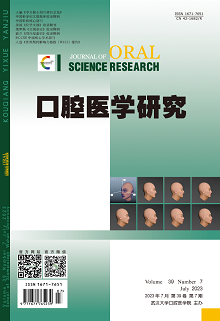|
|
Antibiofilm Activity of Irrigation Protocols Activated by Lasers in Vitro
SU Zheng, YANG Zi, AN Ting, HOU Benxiang
2023, 39(7):
607-612.
DOI: 10.13701/j.cnki.kqyxyj.2023.07.008
Objective: To evaluate the sterilization effect of laser activated irrigation technique on bacterial biofilm. Methods: Supragingival and subgingival plaque of healthy volunteers were selected. Hydroxyapatite (HAP) disks coated with collagen were used as carrier. After 21 days of anaerobic culture, bacterial biofilms were formed on HAP disks. Specimens were divided into control group and experimental groups, in which experimental groups used conventional needle irrigation (CNI), passive ultrasonic irrigation (PUI), EDDY, Nd:YAG laser, Diode laser, Er:YAG photon-initiated photoacoustic streaming (PIPS), and Er:YAG shock wave enhanced emission photoacoustic streaming (SWEEPS), respectively. After treatment, bacterial biofilms were scraped from HAP disks, diluted by gradient, and cultured at 37 ℃ for 72 h. Meanwhile, quantitative polymerase chain reaction (PCR) was used to detect the copy number of bacterial universal genes and Streptococcus intermedius genes. Results: The total number of bacteria initially culturable by biofilm was (11.33±2.50)×108 CFU/mL. The average sterilization rate of CNI was 71.23%. There was no significant difference in the sterilization rates of Diode and Nd: YAG laser (P>0.05), and average sterilization rates were 86.46% and 87.06%, respectively. PUI, EDDY, and PIPS could significantly improve the sterilization effect of NaOCl compared with CNI (P<0.01), but there was no significant difference between them (P>0.05). The SWEEPS group had the highest sterilization rate of 99.93%, showing significant differences from all groups (P<0.05 or P<0.01). Meanwhile, the SWEEPS group had the lowest number of bacterial universal gene and Streptococcus intermedius genes copies, and there were statistical differences compared to the control group, CNI group, Nd: YAG group, and Diode laser group (P<0.05). Conclusions: Laser activation, especially Er: YAG-SWEEPS mode, could significantly improve the sterilization effect on bacterial biofilm of NaOCl.
References |
Related Articles |
Metrics
|

